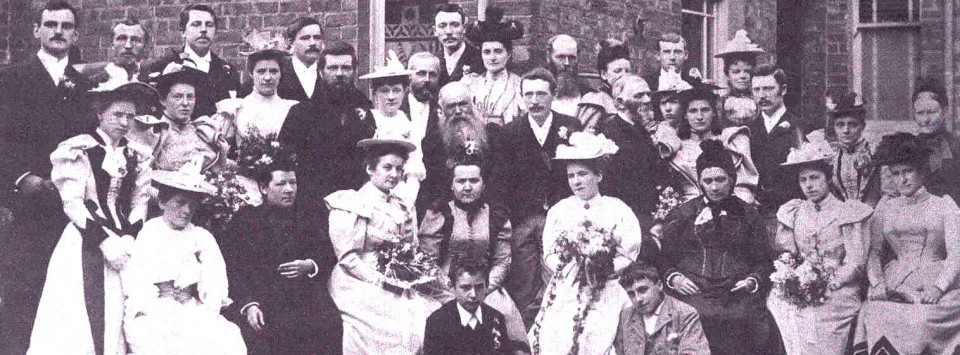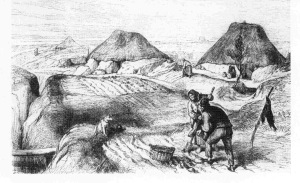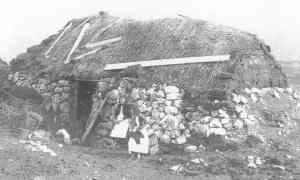Tags
America, army, Castlerea, Co. Roscommon, Conacre, Concar, Corcoran, Irish Constabulary, police, Poverty, Ribbonism, Rockite, Stafford, Tibohine
The last post looked at the miserable conditions in the Castlerea area in the thirty years before the Famine. This week we look at the ways in which people and families could deal with their poverty and helplessness. There were five main things they could do: emigrate, work in local trades, work in the public services, do seasonal work elsewhere or take direct action against their oppressors. Some people, of course, did more than one of these things.
Emigration was the least popular option before the Famine, and local reports suggest few people left the Castlerea district for destinations overseas. The 1836 Irish Poor inquiry reported that the largest numbers were leaving from the land-hungry parishes of the grazing lands in Roscommon, but even here the biggest total in three years was only 50 from Tisrara and Taghboy parishes. In most of north-east Galway, south-east Mayo and north-west Roscommon ‘none’ or ‘few’ people had left, although 58 were noted from Dunamon in Co. Galway and 20 families from Tibohine in Roscommon. The 58 from Dunamon had been ‘assisted’ by their landlord, Sir George Caulfield. This was the only clear case of ‘landlord-assisted’ emigration reported in the whole district, and the people who left were ‘all of the poorer class’. It was not the general picture, however. Most of the poor could not afford the fare and many of those leaving were ‘of rather a decent description’ (Tuam), ‘a publican’s family’ (Kilmovee), ‘two families (Protestants) … of the class of small farmers’ (Estersnow and Kilcolagh), ‘pensioners’ (Kilkeevin) as well as ‘some tradespeople and a few of the gentry’ (Fuerty).[1]
Most of Castlerea’s overseas emigrants went to America, a few to Canada and in only one case was Australia mentioned. The evidence suggests that the Catholic, often Irish-speaking, poor were reluctant or unable to leave and that the emigrants came disproportionately from the relatively better off Catholic sub-tenants, farmers, artisans and small gentry, as well as Protestants. The picture does not seem to have changed much in the ten years before the Famine.
The second way people could get out of poverty was theoretically by working in local manufactures, handicrafts or services. There was no industrialised manufacturing in the area. Work in the domestic linen trade would have been an option as late as 1820, but by the 1830s the flax and linen trade was dead.[2] It was an example of the deindustrialisation that hit Ireland after the 1800 Act of Union. We saw in a recent post (28 July 2015) that Patrick Corcoran from Tibohine adopted the most feasible approach, that of getting a trade. He became a joiner and went to the town of Castlerea. It was still a pretty miserable existence, however, and in 1834 it was stated that, in Castlerea, people in trade were often forced to beg.[3] The poverty of people in the area meant most could not afford the services of craft workers and the opportunities for escape that way were limited.
A superficially good way off the land was to join the army or the police. This path meant, however, breaking with close knit family ties based on the land economy. Such individuals were forced to enter the ‘modern’ world of state organisation and control and they had to make a radical shift in basic attitudes and identities in the process. Given the British state’s colonising status and policies in Ireland, its servants recruited from the ethnically Irish population inherently faced conflicts between the value systems inherited from their family backgrounds and those from their new employers. Whilst, for some, service in the forces and police heightened their Irish nationalist identity and provided them with valuable military or paramilitary training, for most it was just a route out of poverty that meant acceptance of, or at least acquiescence to, the ideologies and rituals of the British Empire. We saw in a recent post (10 July 2015) how John Ryan had followed this route out of Ireland but had ended up in Stafford poverty-stricken and disturbed at the end of his army service. In 1830 42.2% of British army soldiers were Irish-born and typically they were Catholic, poor and from a rural background.[4]
Similarly, young single men could leave grinding poverty on the land by joining the police. The development of state power through the forces of law and order culminated in the founding of the Irish Constabulary in 1836. Before the Famine about sixteen per cent of the Constabulary’s recruits came from Connacht – from areas like Castlerea – and the majority were Catholic farm labourers. Recruitment to the police meant both leaving the land and leaving the district, since they were not allowed to serve in their county of birth to divorce them from the influence of local relatives and associates.[5] In many cases men who started in the Irish constabulary subsequently moved to the new forces in Britain, the Empire and America.
Service in the forces or police was, therefore, a significant way in which young men from Castlerea and the west of Ireland could break out of their impoverished and insecure existence, but only a minority could take that route. The main way people could make money to pay the rent and keep their families fed and housed was by seasonal work elsewhere, particularly in Britain. It was also the main route by which the connections were made which ultimately led to permanent emigration before, during and after the Famine. Seasonal migration developed after 1815 over a good deal of north-west and north-central Ireland, but particularly in the overpopulated parishes of north-west Roscommon and adjacent parts of Mayo and Galway. Perhaps the clearest picture was painted in the parish of Kiltullagh where Thomas Feeny, the Catholic priest, reported that
‘there are 1,320 families in this parish; I may say all of them poor. One and sometimes two men out of each of the most of these families go periodically to England or to Leinster, but more frequently to England, to obtain employment’.
In Kilkeevin (covering Castlerea) ‘hundreds leave their dwellings’, whilst in Templetogher and Boyounagh, Co. Galway, about 700 went away ‘of whom 300 go to England in harvest time’. The picture was similar in adjacent parts of Co. Mayo, where, for example, correspondents from Kilcolman, Kilmovee and Castlemore reported substantial numbers going to England.[6] These were men like Michael Byrne who, in the summer of 1841 lodged in the stable loft at a farm in Baswich near Stafford, Moses Cummings in the poultry house on Ingestre Estate or Dominick Dooly, John Gallagher and Michael Mullony in barns in Hopton parish.[7] Patrick Featherstone from Ballintober almost certainly arrived in Stafford in the same way. Having planted their potatoes they would set off in time to be in England for the hay and grain harvests. Most walked to Drogheda or Dublin, but on the way back some with money in their pockets could use the packet boats of the Royal and Grand Canals from Dublin.[8] Such extravagance was probably rare, however. Staffordshire, along with Cheshire and south Lancashire, was an attractive area to look for harvest work since it was relatively close to Liverpool. The county was but one of the many destinations in Britain to which such seasonal migrants went, but the connection with workers from the Castlerea area seems to have been particularly strong.
A final reaction to the problems people faced was through direct and violent action. In the first half of the nineteenth century the Castlerea district saw a lot of rural unrest.[9] In 1795 the Defenders, influenced by the United Irishmen, carried out acts of violence in Roscommon and it is clear the main issue was already rents and access to potato land.[10] Between 1813 and 1816 agrarian secret societies – the Threshers and Carders – carried out attacks on landlords and middlemen, and the millenarian Rockite movement was active at the same time. The crisis conditions after the Napoleonic Wars produced the Ribbon uprisings of 1819-1822, and the parish of Moylough has been called the ‘nerve centre of Ribbonism’ in north-east Galway, partly because of the arrogant stance of the local land-owning rector, the Rev. John O’Rourke.[11] There were significant Ribbon actions in Castlerea, Oran, and Tibohine during the same period.[12] The adjoining districts of Co. Mayo were generally quiet during the Ribbonite uprisings, but increased poverty there in the 1829-31 period led to large assemblies of people gathering to protest over rent levels and the lack of conacre land.[13]
The conacre movement, often allied to opposition to tithes for the Church of Ireland, flared intermittently across the whole district in the 1830s and it culminated in the Molly Maguires of the mid-1840s. The Castlerea district of Roscommon was a major focus of assemblies and direct action to seize the hated grazing land and turn it into conacre plots. ‘County Roscommon had reached a heightened pitch of agrarian class conflict on the eve of the famine’[14] and this led to seasonal workers bringing back arms from England, including Staffordshire. In the post of 3 March 2015 we saw how Patrick Concar and his associates were arrested at Athleague carrying ‘guns and pistols as perfect as if [they were] out of a military barrack.’[15]
In sum, the Castlerea district before the Famine was a land of burgeoning poverty, misery and violence, and the desperate need to earn enough to survive forced many individuals and some families to leave the area either for seasonal work elsewhere or permanently. Many of the seasonal workers went to Staffordshire, some to the Stafford area, and the contacts built up there were valuable when the Famine disaster struck.
[1] ‘Some had received a little assistance’ in Roscommon parish, but from whom was not stated. Royal Commission on the Condition of the Poorer Classes in Ireland, 1836, Appendix F, questions 30-32.
[2] The number of beggars in Castlerea in 1834 was stated to be double that of ten years previously, partly due to the loss of the flax and linen trade. Parliamentary Papers 1835, Vol. XXXII Pt. 1, Appendix to the First Report of the … Inquiry into the Poorer Classes in Ireland, Baronial Examinations, Ballintobber Barony, Kilkeevin Parish, p. 511. In 1832 Weld wrote that at the Castlerea market ‘linen yard formerly sold in considerable quantity but with cessation of demand the supply stopped, Isaac Weld, Statistical Survey of the County of Roscommon, (Dublin, R. Graisterry, 1832), p. 480 and pp. 682-4.
[3] PP1835, First Report … Poorer Classes, p. 512
[4] E.M. Spiers, ‘Army organisation and society in the nineteenth century’ in T. Bartlett and K. Jeffery (eds.), A Military History of Ireland, (Cambridge, CUP, 1996), Table 15.1, p. 337; Peter Karsten, Irish soldiers in the British army, 1792-1922’: suborned or subordinate?’, Journal of Social History, XVII (Fall 1983) p. 36-7; D. Fitzpatrick, ‘Ireland and the Empire’ in A. Porter (ed.), Oxford History of the British Empire: Vol. III: the Nineteenth Century, (Oxford, OUP, 1999), pp. 510-512; Thomas Bartlett …; K. Kenny, ‘The Irish in the Empire’ in K. Kenny (ed.), Ireland and the British Empire, (Oxford UP, Oxford, 2004), pp. 104-5
[5] W.J. Lowe and E.L. Malcolm, ‘The domestication of the Royal Irish Constabulary, 1836-1922’, Irish Economic and Social History, XIX (1992), pp. 27-48; D. McCabe, ‘Law, Conflict and Social Order: Co. Mayo, 1820-1845’, Unpub. D. Phil. Thesis, University College, Dublin, 1991 (no. 5640), pp. 223-287.
[6] PP1835, First Report … Poorer Classes, Answers to questions relating to the relief of destitute classes: question 5 ‘what number of labourers are in the habit of leaving their dwellings periodically to obtain employment, and what proportion of them go to England?’
[7] Census enumeration returns, Stafford area, 1841
[8] J.H. Johnson, ‘Harvest migration from nineteenth–century Ireland’, Transactions of the. Institute of British Geographers., 41, June 1967, p. 102
[9] M.J. Huggins, “Agrarian conflict in pre-famine County Roscommon”, Unpublished D. Phil. Thesis, University of Liverpool, (2000), chaps. 1 and 2.
[10] Anne Coleman, Riotous Roscommon: Social Unrest in the 1840s, (Dublin, Maynooth Studies in Local History 27, Four Courts Press, 1999), pp. 14-15
[11] C. O’Regan and J. Jones, Moylough: a People’s Heritage, (Moylough Community Council, 1993), p. 82; J. Clarke, Christopher Dillon Bellew and his Galway Estates, 1763-1826, (Dublin, Maynooth Studies in Local History, 49, Four Courts Press, 2003), pp. 54-57
[12] Huggins, ‘Agrarian Conflict’, pp. 176, 160, 190 and 191.
[13] D. McCabe, ‘Law, Conflict and Social Order: Mayo, 1820-1845’, Unpub. D. Phil. Thesis, University College Dublin, 1991 (No. 5640), pp. 198-207
[14] Huggins, ‘Agrarian Conflict’, pp. 260, 263, 272 and 273-5
[15] National Archives of Ireland (NAI), Outrage reports, Roscommon, doc. 25/19637, report of magistrate Matthew Browne to Dublin Castle, 17th September 1845.


